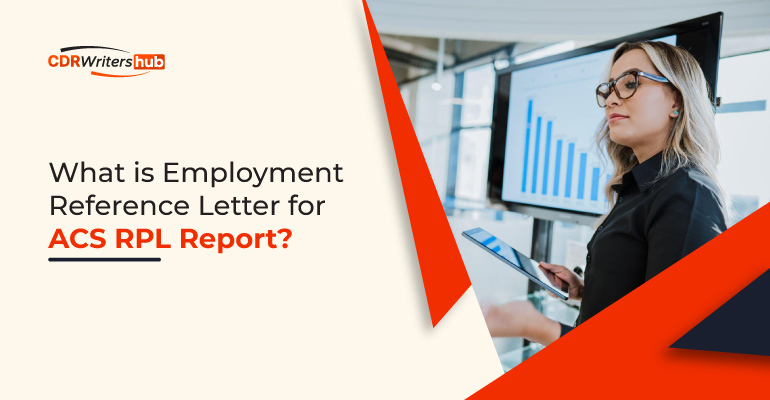What is Employment Reference Letter for ACS RPL Report?

What is Employment Reference Letter for ACS RPL Report?
An Employment Reference Letter is crucial to the ACS (Australian Computer Society) Recognition of Prior Learning (RPL) Report. It’s a document that ACS assessors pay close attention to because it helps them understand your work experience and skills better.
Suppose you’re an aspiring IT professional undergoing the ACS RPL Report process. In that case, you need to know what the Employment Reference Letter is, why it’s essential, and how it affects your RPL application.
Significance of the Employment Reference Letter
Table of Contents
The reference letter in the ACS RPL report is for people who might need formal ICT qualifications but have significant work experience in the field. The primary aim of the RPL report is to showcase your knowledge and skills by documenting your work history, detailing relevant tasks, and providing a comprehensive overview of your expertise.
This letter is crucial to your ACS RPL report and is vital to your application. ACS assessors depend on it to confirm your work experience and to assess if your skills and qualifications align with their expectations for ICT professionals. Thus, you must craft a vital Employment Reference Letter for your ACS RPL application to succeed.
Qualification Criteria for the RPL Report
Recognition of Prior Learning (RPL) checks what you’ve learned and experienced to see your skills in a particular field. Remember that the RPL report’s requirements can differ depending on the program or institution checking your past learning.
Here, we outline the qualifications necessary for the preparation of an RPL report:
1. Accredited Australian ICT Qualifications
Individuals with an Australian degree accredited by the ACS Society meet the requirements for the ICT Major Criteria. However, it’s crucial to note that this accreditation does not assure that the qualification aligns with the ANZSCO (Australian and New Zealand Standard Classification of Occupations) occupation.
2. Evaluation of ICT Content in Tertiary Qualifications
Qualifications in this category undergo an assessment to determine if they hold either an ICT Major or an ICT Minor in computing. If the ICT content is lower than a minor’s, we classify the qualification as Non-ICT.
A. ICT Major Criteria
- Bachelor’s Degree Level
To meet an ICT major, applicants must own a three-year bachelor’s degree with at least 33% of the academic curriculum dedicated to Information and Communication Technology. Longer qualifications get evaluated as equal to a three-year AQF Level 7 award, close to a bachelor’s degree.
- Levels of Diploma, Advanced Diploma, or Associate Degree
They categorize a certificate, intermediate diploma, or associate degree as having a major in computing when it encompasses at least 50% of the qualification focusing on ICT. Longer-duration certifications are considered equal to a standard AQF level 5 or 6 award.
- Postgraduate Degree Level
A postgraduate degree qualifies as a computing major when it covers at least 50% of ICT-related coursework and doesn’t need a bachelor’s degree in ICT for admission. Australian postgraduate degrees equate to an AQF Level 8 or higher certificate when they contain at least 67% ICT content and include at least 12 subjects.
Postgraduate qualifications must meet one of these criteria to meet the standards:
- Three semesters or one and a half years of full-time study.
- At least two semesters or one year of full-time study with equivalent ICT content.
- At least twelve units or subjects.
Postgraduate qualifications that need a bachelor’s certification with an ICT major for admission must contain at least 33% ICT content at the postgraduate level.
B. ICT Minor Criteria
Consider a bachelor’s degree with ICT content covering at least two-thirds of the significant need as a computing minor.
C. Inadequate ICT Content
Label qualifications lacking the necessary ICT material for a major as Non-ICT.
D. Criteria for Associated ICT Material
To meet the suitability criteria, ensure the education certificate contains at least 65% relevant ICT material for the claimed profession.
E. Academic Record Statement
List your completed undergraduate courses and the grades earned in your academic record. Provide a guide explaining the grading system. Avoid using web reports, and result slips as valid forms of documentation.
F. Qualification Completed; Graduation Certificate Still Pending
If your qualification includes a thesis or research report, summarize it. Mention the title, your supervisor’s name, and the institution’s name. On the front page of the abstract, specify the percentage and nature of ICT material related to the nominated ANZSCO codes.
G. Thesis or Research Project’s Abstract
If your qualification includes a thesis or research report, you need to provide a summary of it. This summary should have the title of the publication, your supervisor’s name, and the institution’s name. Also, make sure to mention the percentage and type of ICT material related to the chosen ANZSCO codes on the front page of the abstract.
H. Prerequisites as per Region
Requirements may vary based on the region or specific program under consideration.
Employment Reference Letter
The Employment Reference Letter is critical to your ACS RPL (Recognition of Prior Learning) report. This letter holds crucial details about your education, work experience, skills, and abilities. It’s vital to your application because the ACS Society reviews your RPL report based on your work history and expertise. This section will explore the format and rules for creating a comprehensive letter.
This letter offers a glimpse into your professional journey and is crucial in helping you achieve a positive outcome with the ACS. Your work experience must align with the professional ICT level and relate to the chosen ANZSCO (Australian and New Zealand Standard Classification of Occupations) codes to qualify for migration skills assessment.
Format for Employment Reference Letter
Creating a well-structured and detailed Employment Reference Letter is important to meet ACS requirements. Here’s an overview of the recommended format:
1. Dates in the DD/MM/YYYY Format
Ensure all dates get written throughout employment in the DD/MM/YYYY format. This consistency aids in clear documentation of your work history.
2. Position in the Given Field of Work
State your job title or position within the field of work. This information serves as a crucial reference point for ACS assessment.
3. Duties Accomplished While in the Workplace
Provide a comprehensive list of your duties and responsibilities during your employment. Be specific and detailed in your descriptions to help assessors understand the nature of your work.
4. Mention Previous Positions and Responsibilities (if Relevant)
If you held any previous positions within the organization or other relevant roles, mentioning them in your Employment Reference Letter is essential. Highlighting these experiences can provide a more comprehensive view of your career progression.
5. Specify Working Hours
State the nature of your full-time or part-time employment and provide information about the average weekly hours worked. This detail helps in assessing the extent of your work experience.
6. Include the Workplace Address
Make sure to include the address of the organization where you get employed. This information adds context and verifiability to your work history.
7. Utilize Organizational Letterhead
Your Employment Reference Letter should be presented on the organization’s official letterhead. This letterhead should include the organization’s name, logo, and contact details.
8. Signatures by an Authorized Individual
An authorized individual within the organization must sign the letter. Digital signatures are acceptable, provided they are verifiable. The person signing the letter should have the authority to do so on behalf of the organization.
Critical Points for Employment Reference Letter
Besides the format, several key points should be noted when preparing your Employment Reference Letter. These points ensure that your reference letter meets ACS standards and represents your work experience:
1. “To Date” for Current Employment
If you currently hold a job, add the phrase “To Date” to your employer reference letter and the date of letter preparation. This format indicates that your employment is ongoing.
2. Evaluation of Experience Until Submission Date
ACS assesses your work experience up to the submission date of your application. They won’t consider any experience gained after this date.
3. Importance of Describing Responsibilities
Describing responsibilities in your work reference is crucial in determining their relevance to your chosen occupation. Be explicit in detailing the tasks you performed and the skills you applied in your role.
4. Clarity and Interpretation
Ensure your Employment Reference Letter includes precise dates and responsibilities to ensure clarity and clarity. Unclear or vague information can lead to ACS deeming your work experience unsuitable.
5. Qualification-Related Work Experience
Categorize work experience gained as part of a “Concurrent Employment” qualification and distinguish it from professional work experience. ACS does not count it as skilled employment.
6. Age Limit for Work Experience
ACS only accepts work experience obtained after turning 18 as skilled employment. Instead, it labels it as “non-professional level ICT experience.
7. Specificity in References
Avoid generic references lacking specific job duties; ACS assessment considers them unsuitable due to insufficient information. Your Employment Reference Letter should highlight your contributions and achievements.
8. Avoid Copying from ANZSCO
Copying and pasting tasks from the Australian and New Zealand Standard Classification of Occupations (ANZSCO) is not permissible. Your reference should reflect your experience and contributions.
9. Separate Reference for Each Episode of Work
You must provide an Employment Reference Letter for each distinct work episode. If you’ve held various roles or worked for different organizations, ensure each reference offers detailed information about your responsibilities and skills. An authorized person from your company should sign the letter, including their name, job title, and contact information.
Considerations When Drafting an Employment Reference Letter
- If you hold a job presently, ensure your employer’s reference letter includes the phrase “To Date” and when they wrote it.
- ACS evaluates your work experience up to the moment you submit your application.
- The relevance of the job description in your employment reference relies on how you outline your responsibilities for your chosen occupation.
- We assess the suitability of a work episode as unsuitable if the dates or duties mentioned need clarification or are open to interpretation.
- Work experience gained as part of a qualification falls under the “Concurrent Employment” category and doesn’t qualify as skilled employment.
- Any work experience acquired before turning 18 isn’t regarded as skilled employment and is documented as “non-professional level ICT experience.”
- Generic references lacking specific job duties get designated “Not Suitable due to insufficient information.”
- Copying and pasting tasks from the Australian and New Zealand Standard Classification of Occupations (ANZSCO) is not acceptable as valid references.
You must provide a separate employment reference letter for each work episode. These letters should contain detailed information about your job responsibilities and skills. Your employer must also sign them or an individual authorized by your company, with their name, job title, and contact details stated.
Conclusion
The Employment Reference Letter plays a crucial role in your ACS RPL Report. ACS assessors can see if your skills and qualifications meet ICT industry standards. This letter is your chance to highlight your abilities and accomplishments in information and communication technology.
Recognizing the significance of the Employment Reference Letter and crafting it can enhance your prospects of a successful ACS RPL assessment. As you begin your RPL journey, remember that this document is more than words—it’s your tool to showcase your skills and access opportunities in the ever-evolving ICT world.
When it comes to preparing your Letter for ACS Australia Services, it’s essential to approach the task with dedication and precision. Your ACS RPL report is your key to demonstrating your engineering skills and qualifications to the Australian Computer Society (ACS). At CDRWritersHub, we understand the importance of this document and the impact it can have on your career prospects in Australia.



